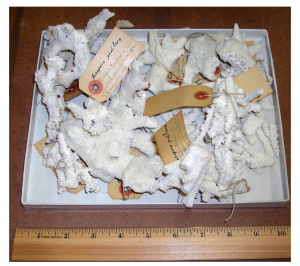Navigation
Barbados Fringing Reefs & Seagrass Beds
— Obs I
— — The Acroporoids
— — — A prolifera (This Page)
Subpages of This Page:
– A. prolifera “Mother Colony”
Also View:
– Acropora prolifera (fused staghorn coral) in Barbados’ MPA 2015
Photo album.
– Acropora prolifera on Barbados fringing reef (iNaturalist Project).
There are currently
– 27 separate records for A prolifera
(fused staghorn coral; the hybrid)16 seoarate records for A. palmata
(elkhorn coral, one of the two parents of A. prolifera)14 separate records for A. cervicornis
(staghorn coral, one of the two parents of A. prolifera)
– For some background on the Vauxhall Reef, occurrence of Acroporoids on the reef, see: Photographs 2015/2016 (mostly at Vauxhall)
SOME LINKS
Coral Hybrids (YouTube)
ChangingSeasTV. “While Elkhorn and Staghorn corals have undergone a drastic decline in the Caribbean, their hybrid, “Fused Staghorn,” is increasing in numbers in parts of the region. One scientist is studying the animals in Belize to see if the hybrid might be better equipped to deal with environmental stressors than its parents.” Tip of the Hat to Susan M. for passing this on.
The Endangered Corals of Fisher Island & The Saga of The Deep Dredge (Pt. 2 of 3)
On https://coralmorphologic.com/, May 21st, 2015. Includes a YouTube video
“The most remarkable aspect of the health of the corals growing on Fisher Island, is the success story of two hybrid fused-staghorn corals (Acropora prolifera) that live along its shorelines. The story of the first hybrid coral is well documented through the TEDxMIA talk Colin conducted in 2011. This hybrid coral appears to be much more palmate in its growth morphology which typically means that its mother was a staghorn and its father an elkhorn. This coral has proven to be the most remarkably resilient of the Fisher Island Acropora corals. While its growth has been somewhat slow, it has never demonstrated any evidence of significant die-off, white pox, or bleaching. It also features significant amounts of fluorescent green proteins which may confer it with an adaptive advantage over its non-fluorescent parent species.”
Should Hybrids Be Used in Coral Nurseries? A Case Study Comparing Caribbean Acropora spp. and Their Hybrid in the Bahamas
Cassie M. VanWynen1 et al., in Front. Mar. Sci., 13 August 2021 “…his study highlights the rapid growth rate of hybrid corals and suggests that fragment sections have equivalent survival and growth. Consequently, these results suggest that restoration managers may capitalize on fast growing hybrids for outplanting to degraded reefs and to increase the scale of nursery projects.”
Population dynamics and genotypic richness of threatened Acropora species and their hybrid in the U.S. Virgin Islands
Hannah F. Nylander-Asplin et al., Coral Reefs Volume 40, pages 965–971, (2021). “Acropora cervicornis and A. palmata have experienced substantial losses in coral cover throughout the Caribbean, but their hybrid (A. prolifera) appears to be increasing at some sites. The shifts in relative abundance could result from hybridization with subsequent asexual fragmentation, recent increased hybridization, or a disproportionate loss in the parental species…To further explore acroporid dynamics at these sites, we analyzed existing photo transects from 2009 to 2017 to reveal significant losses of A. cervicornis but stable hybrid percent cover. High genotypic richness and stable populations suggest acroporid hybrids may become the primary shallow reef-builders in some locations previously occupied by the parental species.”
A. G. Mayer 1915: Acropora prolifera
From Smithsonian Info:
Title: Acropora prolifera
Creator: A. G. Mayer
Date Created: 1915
Specimen Count: ca.60
Location Created: Brighton, from reef exposed to sea, 1 mi off shore, 2-4m depth, Barbados, North Atlantic Ocean
Preparation: Dry
Fossil Acropora prolifera (Lamarck, 1816) reveals coral hybridization is not only a recent phenomenon
William F Precht et al., 2019 Proceedings of the Biological Society of Washington 132(1):40 DOI:10.2988/18-D-18-00011 “Acropora prolifera is an ecologically distinctive western Atlantic reef-building coral that originates from hybridization and back-crossing between A. palmata and A. cervicornis. It has been suggested that A. prolifera might be a recent product of precipitous decline in the abundance of the two parent species, forcing hybridization where both it and its product might not otherwise be prevalent phenomena. We present evidence that A. prolifera has a fossil record dating back to at least the late Pleistocene, and that it was ecologically significant prior to the region-wide die-back of acroporid corals. These data, when taken collectively, reveal that hybridization in the Caribbean acroporids is historically rooted and not a recent artifact of changes in Caribbean reef ecology. It is becoming apparent that hybrid taxa likely play an important but underappreciated role in coral reef ecology and reef-building more generally. This is consistent with recent recognition that interspecific hybridization can drive evolutionary innovation and cladogenesis in animals as well as plants.”

